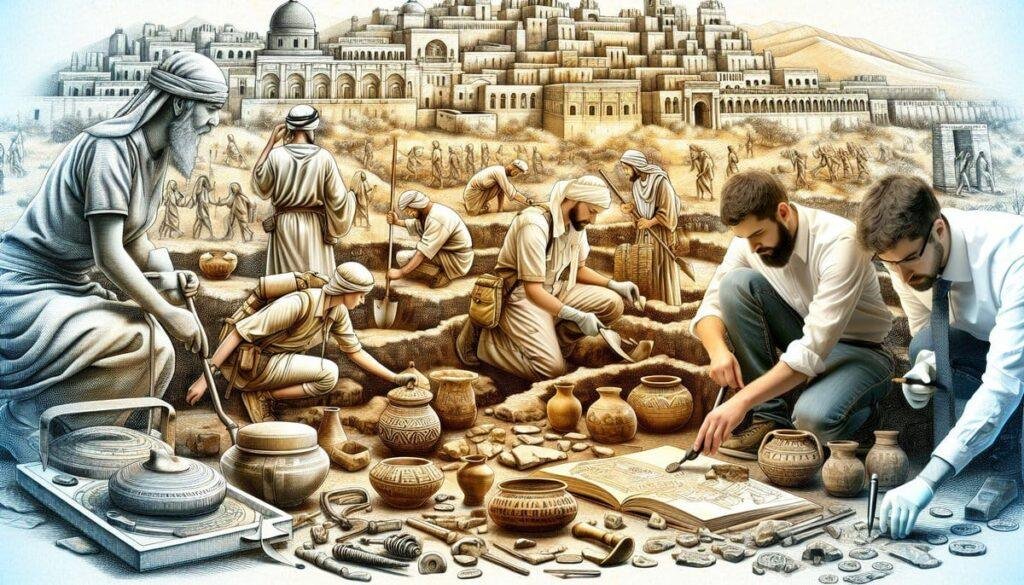Have you ever found yourself wondering how a symbol, an ancient artifact like the Ark of the Covenant, could embolden a person or an entire nation facing overwhelming odds in battle? The tales and traditions surrounding the Ark are rich with history and spiritually charged anecdotes, hinting at a profound impact on human courage and tenacity. In this piece, we’ll embark on a journey to unravel the layers of the Ark’s significance, particularly focusing on its role in inspiring the outnumbered during desperate times.

The Ark of the Covenant: An Overview
The Ark of the Covenant is far more than just a physical object; it’s a cornerstone of faith, history, and cultural identity. Made of acacia wood and covered in gold, this ornate chest contained the tablets of the Ten Commandments, a jar of manna, and Aaron’s rod that budded. Each item held rich symbolic meaning and was central to the Hebrew faith.
Historical Significance
Dating back to the time of Moses, the Ark represents God’s presence among His people. Archaeological records suggest that the Ark was not only a religious artifact but also a symbol of divine protection and guidance during tumultuous times.
- Biblical Accounts: The Book of Exodus presents the Ark as a means through which God communicates with His chosen people.
- Archaeological Findings: Some artifacts uncovered at various Biblical sites corroborate stories surrounding the Ark, further highlighting its influence on ancient Israelite culture.
The Ark as a Symbol of Hope
When you’re outnumbered in a challenge—be it a physical battle or a metaphorical one—the symbol of hope often becomes your strongest ally. The Ark served this very purpose for the Israelites, reminding them of their covenant with God and instilling a sense of divine support even in the bleakest scenarios.
The Role of the Ark in Battles
Throughout various scripture passages, the Ark is depicted as an active participant in battles. Its presence alone uplifted spirits and altered the course of events. Let’s take a closer look at some of these accounts.
The Battle of Jericho
One of the most iconic tales of the Ark’s involvement in battle comes from the siege of Jericho. The Israelites, led by Joshua, marched around the fortified city with the Ark at the forefront for six days. On the seventh day, they circled it seven times, and with a mighty shout and the sound of trumpets, the walls came tumbling down.
- Empowerment Through Presence: The psychological effect of carrying the Ark showcased faith in action; it galvanized a people into collective movement, reinforcing their belief in divine support.
- Strategic Element: Military or not, the Ark became a pivotal point in their strategy, proving that sometimes, faith can tip the scales in unexpected ways.
The Battle Against the Philistines
Another significant episode is the battle at Aphek, where the Israelites faced the Philistines. In a moment of desperation, the Israelites brought the Ark to the battlefield, believing its presence would secure victory.
- Misperception of Power: While the Ark itself is a divine symbol, its mere presence could not guarantee victory without a commitment to faith and morality.
- Resulting Lessons: The unfortunate defeat serves as a stark reminder that reliance on symbols must be rooted in actual spiritual commitment for them to be truly effective.

Theological Insights: Courage Through Companionship
The Ark’s power goes beyond mere presence; it represents companionship with God. By forming a bond established in faith and trust, the Ark reminds you that you are never truly alone in your fight.
The Concept of Divine Support
Many religious scholars underscore the importance of divine support in challenging situations. When you feel outmatched, remembering that you have a higher force backing you can lift your spirits.
- Spiritual Resilience: The Ark can serve as a symbol of resilience, urging you to face adversities head-on, knowing you’re supported.
- Collective Courage: With the Ark, the Israelites became a unified front; their collective faith reinforced their individuality, amplifying their courage together.
The Ark’s Cultural Influence Throughout History
Step back and consider how the symbolism of the Ark has morphed through the ages. It’s a real testament to human resilience, not just in Biblical tales but also in cultures across the world.
Symbolism in Art and Literature
The Ark has inspired countless artists and writers. Consider how its image has been woven into narratives that speak of hope, strength, and perseverance.
- Religious Art: From paintings to sculptures, the Ark’s various depictions often illustrate the union of divine power and human courage.
- Literature: Writers across generations have utilized the Ark in their works, employing it as a metaphor for overcoming insurmountable challenges.
Modern Psychological Perspectives
In today’s world, psychological studies delve into how symbols—much like the Ark—can influence human behavior. When faced with adversity, leaning on powerful symbols can stimulate resilience and courage.
- Cognitive-Behavioral Insights: Research supports the idea that external symbols can enhance internal motivation, pushing you toward bravery.
- Community Rituals: Many contemporary groups use historical symbols to forge connections and foster collective strength, reinforcing that age-old bond between the sacred and the courageous.
Bridging Ancient Lessons to Modern Challenges
What can you take away from the tale of the Ark when it comes to your modern battles? Its legacy holds lessons applicable to myriad challenges you face today—be they personal, professional, or communal.
Resilience in Uncertain Times
In a world that can sometimes feel daunting and unpredictable, connecting with symbols of strength can forge pathways to resilience.
- Finding Your Ark: Identify what symbolizes courage for you. It could be a physical artifact, a mantra, or a remnant of your culture.
- Community Empowerment: Surrounding yourself with supportive networks can amplify that sense of security, much like the Israelites found in their faith and collective identity.
Embracing the Power of Faith and Belief
Just as the Israelites found strength in the Ark, you too can harness the power of belief during trying times.
- Personal Reflection: From a quiet moment of reflection to active manifestations of your beliefs, find what anchors your spirit.
- Maintaining Integrity: Much like the lessons learned from the interactions with the Ark, you may realize that maintaining personal integrity in the face of adversity can yield greater results than you initially anticipated.
The Lasting Impact of the Ark
As we turn the final pages on this narrative, it’s vital to reflect on how the Ark continues to resonate deeply within your own life and countless others. Its teachings endure, providing frameworks for courage in times of desperation.
Cultural Continuity
The Ark symbolizes an unbroken bridge to the past—a legacy that transcends time, reminding you of your connection to ancient struggles and triumphs.
- Historical Reminders: Every time you acknowledge the Ark’s history, you’re participating in a broader conversation on resilience and faith.
- Personal Storytelling: Sharing your challenges alongside the historical context of courage can create powerful connections within your communities.
Conclusion: Courage is a Collective Journey
As you contemplate the influence of the Ark of the Covenant throughout history and its role in uplifting courage among the outnumbered, remember that courage isn’t just an individual quest; it’s a collective journey. Strength exists in community, faith, and shared symbols that remind you of your capacity to stand tall against formidable challenges.
Your narratives—woven with elements of both personal struggle and universal themes—carry the torch lit by the Ark, sparking the light of hope for future generations. By embracing what the Ark represents, you not only acknowledge the past but also shape a future characterized by resilience and unwavering courage.


